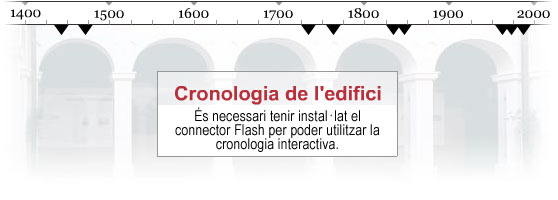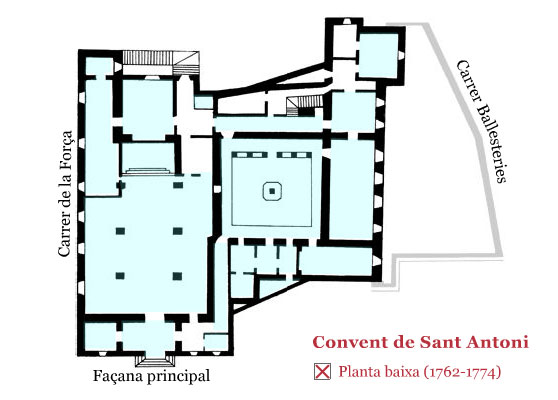History of the Building
The building that today houses the City History Museum and is popularly known as the “Institut Vell” (“Old Institute”) was begun in 1762 by the Capuchin friars. From its arrival in Girona in 1581 until that year, this order had successively occupied various areas of the city. Initially it was housed in the sanctuary of Les Ermites, in Les Pedreres, where the present-day street name Carrer de Caputxins still recalls the presence of the order there.

Later on, probably in 1628, the Capuchins moved to the Mercadal neighbourhood, close to the New Hospital, also known as Santa Caterina. At the end of the Reapers’ War (1640–1652) and because of the construction of the Sant Francesc de Paula bulwark, they returned to the old community of Les Ermites, where they remained until 1707.
Finally, after a brief stay in the vicinity of the Gironella Tower in 1732, the Capuchins were authorised to occupy the Desbach mansion, then the property of the Marquises of Cartellà. This Gothic building, which contained Roman remains from the late 2nd and early 3rd centuries AD and was located between Carrer de la Força and Carrer de les Ballesteries, was partially demolished between 1753 and 1762. During this period, the Capuchins dedicated their efforts to erecting an earth retention wall in order to overcome the height difference between the two streets, while also transforming the basement floor for the community’s new requirements. The works consisted basically in adapting and enlarging the existing spaces for animal shed, stables, cemetery, cellar, cisterns, washhouse, covered gallery, refectory, communication corridors and the flat area created by the retaining wall, used as a garden and probably as a vegetable garden.

The construction of the new building, also known as the Convent of Sant Antoni, was carried out between 1762 and 1774, reusing the materials from the Cartellà mansion. As for the ground or main floor, the church was consecrated in 1764. The entrance was via an arcaded porch opening onto Plaça de la Canonja. Three years later the cloister, the new refectory, the kitchen and almost all of the rest of the rooms had been built.
By the time the Peninsular War broke out (1808-1809), the convent was being used as a theology school. The bombardment by the besieging French army destroyed a large part of the building, particularly of the church and the upper floors. After the reconstruction commenced in 1814, the Capuchins resided in the convent until the definitive exclaustration (1835), from which moment the Girona City Council began to negotiate the conversion of the building into the Provincial Education Institute, which was achieved in 1841. The master builder Espelt introduced the necessary alterations for the new function by dividing the church into two floors and constructing a covered gallery over the cloister. Finally, in 1911 the architect Manuel Almeda carried out a reform project on the façade overlooking the Placeta de la Canonja.
The building is distributed into four floors plus a number of rooms situated around the upper part of the cloister. The basement floor, which is entered from Carrer de la Força, is the oldest part, being previous to the year 1762. The walls are of masonry, while some of the vaults were made of stone, following the pattern of the barrel vault, and the others, made of brick, show various models deriving from the roofs with Baroque lunettes. The abundant remains of blocked openings throughout the floor confirm the documentary references to the transformation and adaptation of earlier constructions which the Capuchin order used when it first occupied the building for the most essential services of the community.
Among the spaces of this floor, we must highlight the cistern, an interesting example of water tank with stone vaults on columns, and the cemetery or desiccator, which has eighteen vertical niches with their corresponding perforated benches where, in accordance with the custom of the order, deceased friars were sat for their bodies to be desiccated. The front wall has a tiled cross with floral decoration in blue enamel.
The new works for the church were commenced in 1762. Of considerable dimensions, it has three naves, a flat chevet and a porch which was reformed early in the 20th century by the municipal architect Manuel Almeda. In the present day the layout of the church is altered by the longitudinal division into two floors and the closing of one of the side naves, alterations which were carried out when the building was converted into a college.
The rest of the ground floor rooms (parlours, refectory, kitchen, etc.), are arranged around the diminutive cloister, as is usual in all Capuchin monasteries. Like the church, this cloister, with small round arcades, was transformed in the mid-19th century with the construction of the covered gallery corresponding to the first floor, while the cells were converted into larger rooms.
The two remaining floors have little architectural value, due to the continual alterations that were carried out when the building was used as an educational institution.
RELATED INFORMATION
> Catalog: History of the Building (PDF 0,9Mb)
